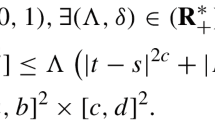Summary
This note is about an occupation time identity derived in [14] for reflecting Brownian motion with drift <InlineEquation ID=IE”3”><EquationSource Format=”TEX”><![CDATA[<InlineEquation ID=IE”4”><EquationSource Format=”TEX”><![CDATA[<InlineEquation ID=IE”5”><EquationSource Format=”TEX”><![CDATA[<InlineEquation ID=IE”6”><EquationSource Format=”TEX”><![CDATA[<InlineEquation ID=IE”7”><EquationSource Format=”TEX”><![CDATA[<InlineEquation ID=IE”8”><EquationSource Format=”TEX”><![CDATA[<InlineEquation ID=IE”9”><EquationSource Format=”TEX”><![CDATA[<InlineEquation ID=IE”10”><EquationSource Format=”TEX”><![CDATA[<InlineEquation ID=IE”11”><EquationSource Format=”TEX”><![CDATA[<InlineEquation ID=IE”12”><EquationSource Format=”TEX”><![CDATA[<InlineEquation ID=IE”13”><EquationSource Format=”TEX”><![CDATA[<InlineEquation ID=IE”14”><EquationSource Format=”TEX”><![CDATA[<InlineEquation ID=IE”15”><EquationSource Format=”TEX”><![CDATA[<InlineEquation ID=IE”16”><EquationSource Format=”TEX”><![CDATA[$]]></EquationSource></InlineEquation>]]></EquationSource></InlineEquation>]]></EquationSource></InlineEquation>]]></EquationSource></InlineEquation>]]></EquationSource></InlineEquation>]]></EquationSource></InlineEquation>]]></EquationSource></InlineEquation>]]></EquationSource></InlineEquation>]]></EquationSource></InlineEquation>]]></EquationSource></InlineEquation>]]></EquationSource></InlineEquation>]]></EquationSource></InlineEquation>]]></EquationSource></InlineEquation>]]></EquationSource></InlineEquation>-\mu<0,$ RBM($-\mu$), for short. The identity says that for RBM($-\mu$) in stationary state <InlineEquation ID=IE”1”><EquationSource Format=”TEX”><![CDATA[<InlineEquation ID=IE”2”><EquationSource Format=”TEX”><![CDATA[$$]]></EquationSource></InlineEquation>]]></EquationSource></InlineEquation>(I^{+}_t, I^{-}_t) \rr (t-G_t,D_t-t),\qquad t\in \mathbb{R},$$ where $G_t$ and $D_t$ denote the starting time and the ending time, respectively, of an excursion from 0 to 0 (straddling $t$) and $I^{+}_t$ and $I^{-}_t$ are the occupation times above and below, respectively, of the observed level at time $t$ during the excursion. Due to stationarity, the common distribution does not depend on $t.$ In fact, it is proved in [9] that the identity is true, under some assumptions, for all recurrent diffusions and stationary processes. In the null recurrent diffusion case the common distribution is not, of course, a probability distribution. The aim of this note is to increase understanding of the identity by studying the RBM($-\mu$) case via Ray--Knight theorems.
Similar content being viewed by others
Author information
Authors and Affiliations
Rights and permissions
About this article
Cite this article
Kozlova, M., Salminen, P. An occupation time identity for reflecting Brownian motion with drift. Period Math Hung 50, 189–198 (2005). https://doi.org/10.1007/s10998-005-0012-x
Issue Date:
DOI: https://doi.org/10.1007/s10998-005-0012-x




